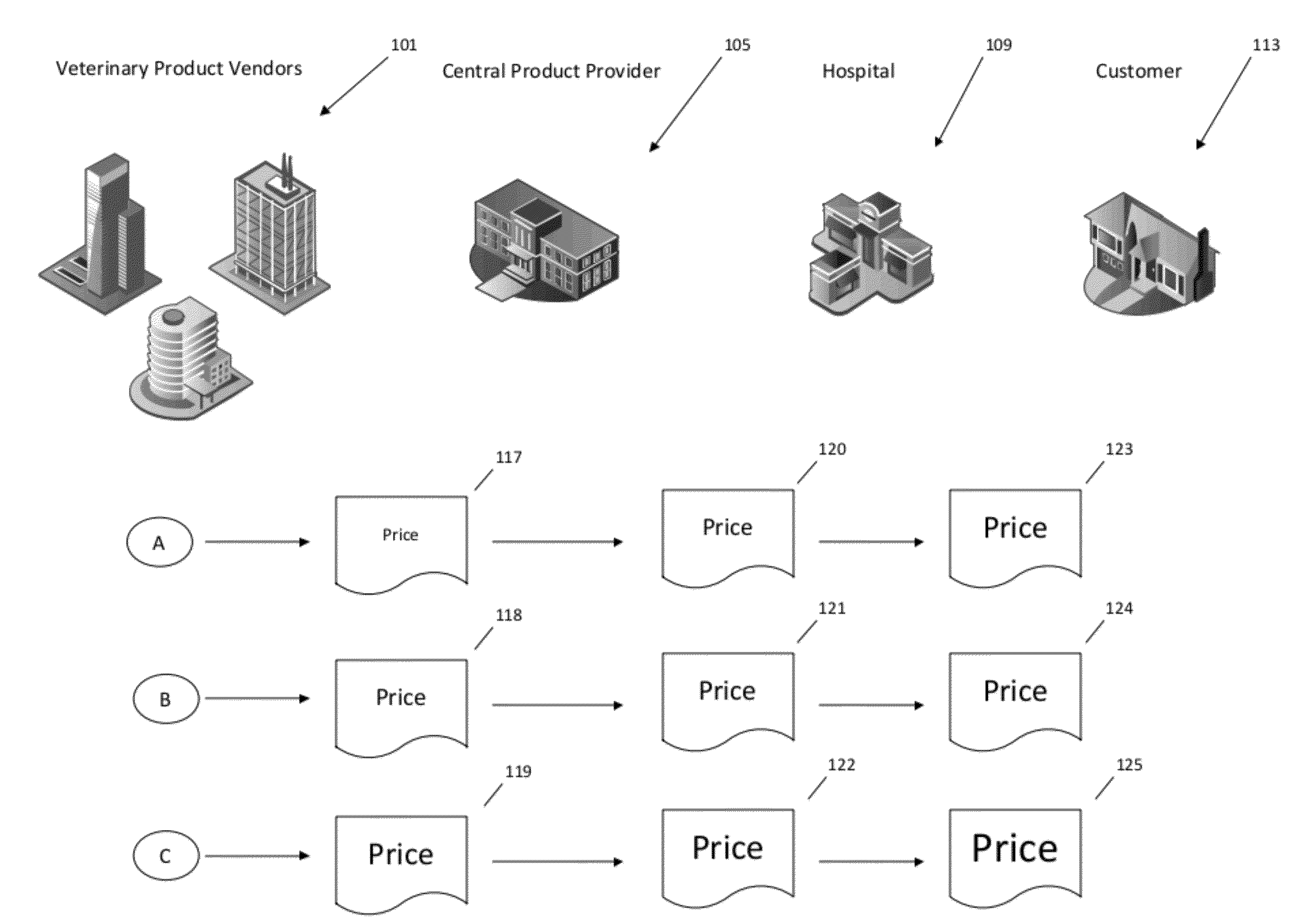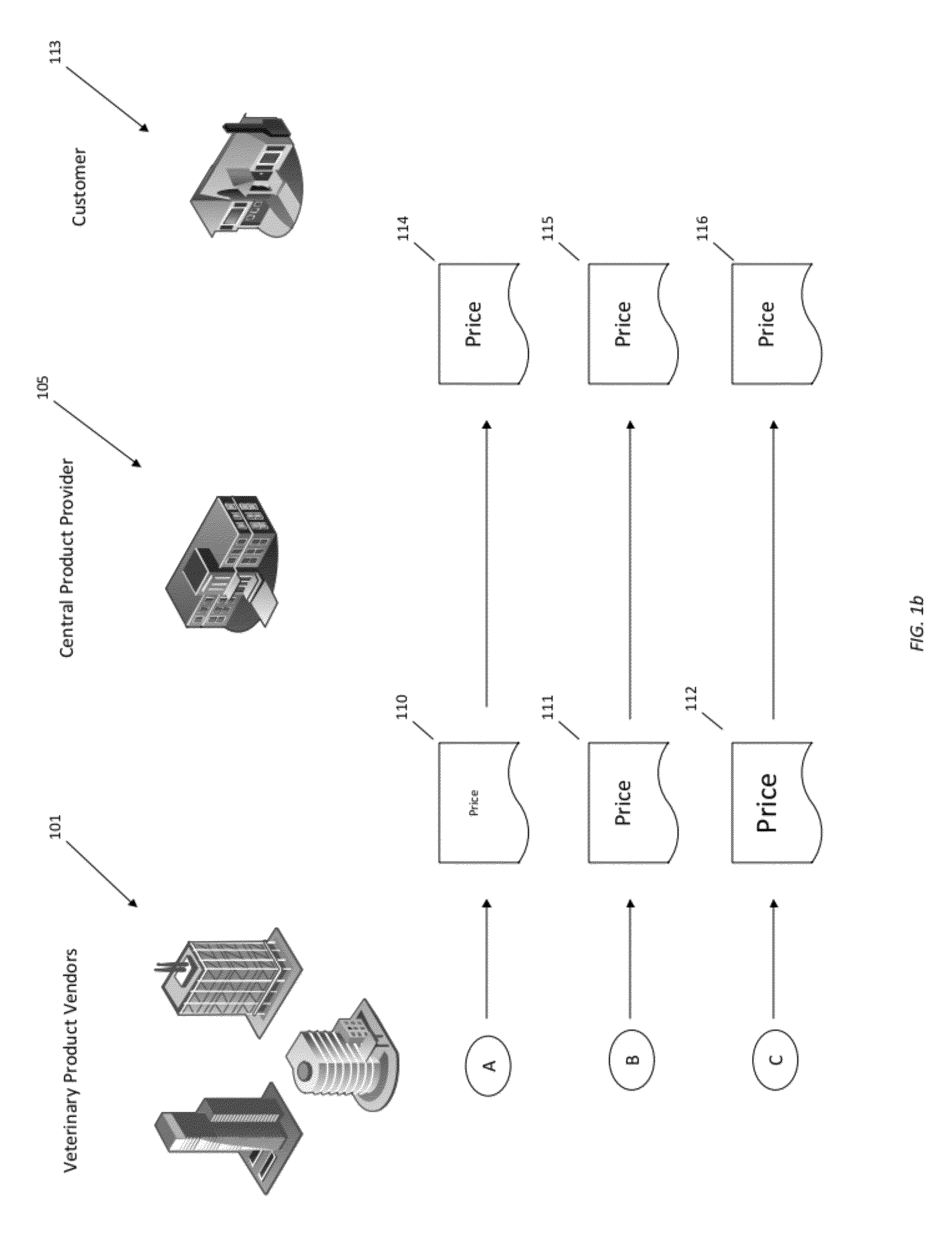Traditionally,
pharmacy's within veterinary hospitals, and especially those within smaller animal treatment facilities or locations where only one or just a few licensed veterinarians have been authorized to do business, have struggled to profitably and effectively manage and dispense veterinary pharmaceuticals and animal supplements.
This has been in part due to the lack of a system for effectively integrating
work flow of animal pharmacies and animal care providers such as veterinarians and veterinary hospitals.
Because there are such a large number of veterinary products that are constantly changing, it is difficult at best for an animal hospital to stay current and remain profitable while managing the large number of products necessary for different animal treatment conditions encountered.
Maintaining inventory against becoming stale or otherwise outdated has been a challenge in such a situation.
Further, from a
product pricing perspective, it has been challenging for individual hospital pharmacies 109 to maintain profitability while wholesale costs on a wide array of products have frequently varied and changed from time to time.
But these centralized pharmacies 105 have not adequately integrated the hospital or veterinarian in the loop of treatment of animals or profitability regarding the sale of veterinary products.
Accordingly, there has been a disincentive in the more traditional centralized veterinary
pharmacy system for animal hospitals to send customers to such centralized pharmacies, since animal hospitals have not been included in the profitability loop and have also reported concerns of losing customers and not being adequately involved in treatment of animals, since such centralized pharmacies have had more exclusive and direct contact with pet owners.
Though some of this problem has been alleviated by legally requiring veterinarians to more frequently see the animals for which prescriptions are made, this doesn't address the lack of profit incentive for veterinarians to deal with traditional centralized pharmacies associated with prior art pricing systems.
Ultimately, it has been understood that
cutting veterinarians out of the animal treatment and profitability loops in animal care has been unwise and has not been good for the animals, their owners, veterinary hospitals or individual veterinarians.
Since there is currently a very large number of supplement and pharmaceutical
treatment options available for animals presenting a wide variety of disorders and conditions, it has been very difficult, if not impossible, for a veterinarian, or a small veterinary hospital, to have maintained in stock sufficient quantities of each of the many and varied medications available, without such supplies becoming stale, losing
potency, or expiring.
Further, the management of such inventory, even if possible, would be very cumbersome, labor intensive, and expensive.
This problem has been exacerbated by the fact that, with some medications or products, the number of animals for which the product may have been beneficially prescribed has been relatively small.
Since the prior art method of pricing and proceeds allocation and distribution has not been dynamic or automated, there has been increased cost to the end-user because the pharmacy has had to increase the price of the product to protect against unforeseen interim wholesale price changes.
Or alternatively, prior art increase changes in wholesale pricing have negatively impacted profitability for the pharmacy.
To date, there hasn't been an effective, comprehensive, integrated and
computerized system in place that would have been highly beneficial to pet owners and animals and that would have incentivized animal hospitals with profitability on pharmaceutical and other product sales.
This has been due, in some part, to the fact that very large product development costs have not previously been able to have been spread over a larger number of customers, such that these large development costs have been prohibitive to making new products.
Without such an integrated system, the products would have been too expensive to develop.
Since an effective product sales channel and associated system and method in which veterinary hospitals could participate profitably has been lacking, this has, in the end, naturally resulted in a more limited range of
treatment options for animals.
More particularly, the inability of prior art centralized pharmacies to more effectively control costs by putting tighter tolerances and
granularity on price change strategies with a computer controlled, dynamic price modification system, in order to better facilitate integration of animal clinics into the product sales transaction loop, whether it be in a
consumer direct or a hospital sale, has been an impediment to profitable participation by veterinarians in this aspect of animal treatment.
Lesser involvement of veterinarians in treatment plans has been shown to negatively
impact compliance by animal owners and others in administering recommended treatments to animals.
Largely, such noncompliance has resulted from inherent
delay and the inconvenience placed upon the owner to return to the veterinarian to renew prescriptions, to hand-carry prescriptions to the local pharmacy, wait to have them filled, and to remember to administer the treatment as prescribed to the animal according to the
treatment plan.
Thus, non-compliance may include any deviation from the
treatment plan of the veterinarian, such as an owner's failure to renew the prescription, failure to refill the prescription and do so in a timely manner, or failure to administer the treatment and do so in a timely manner according to the
treatment plan.
Since the animal has been mostly unable to indicate need for treatment, compliance has been left primarily to the owner in this traditional
scenario, and diminished compliance has resulted.
It is
distressing that there has been a very low compliance rate in the administration of pharmaceuticals to animals, documented as between 34-48 percent among customers of veterinary preventative medications, and 19% for therapeutic diets, as published in the 2003 AAHA study, The Path to High-Quality Care: Practical Tips for Improving Compliance.
Prior art methods have effectively
cut animal hospitals and veterinarians out of the loop because they have not had the profit incentive or the staff support to effectively comply with such regulatory and compliance requirements.
And this, in turn, has negatively impacted the competitiveness of veterinary hospitals and served to limit the number of
treatment options available to animal caretakers.
From an animal pharmacy's perspective, it has been difficult to integrate many disparate providers of animal care services with a
standard product offering that is effectively managed, given the many different products available and the fact that the product
list and pricing is constantly changing.
Such difficulty has further acted to prevent involvement of individual veterinarians and animal hospitals in transactions involving the sale of veterinary pharmaceuticals and other animal-related products, since pharmacies have had only less effective means of marketing to and creating relationships with animal care providers.
Accordingly, it has been a challenge for veterinary hospitals and veterinarians to participate successfully in, and profit from the sale of, pharmaceutical and other animal-related products for treatment of animals seen at the veterinary hospital.
And this, in turn, has negatively impacted the treatment of animals, since already low rates of compliance with veterinary treatment regimens overall are worsened where the veterinarian is not effectively involved, financially or otherwise, in the pharmaceutical and supplement dispensing and supplying process.
This situation is complicated in the case of treatments that have involved the administration of multiple doses of
medicine or supplement on a periodic basis, for example weekly, or daily for a period of time.
Prior non-computerized methods and systems of enabling, controlling and managing the
processing, fulfilling, dispensing and handling of sales of animal-related products have not included a customizable, automated means of product offering, selection, pricing, billing, accounting and proceeds sharing capability to enable veterinarians and animal hospitals to effectively participate and profit from the sale directly to customers of the increasingly larger varieties of products available.
As such, traditional prior art methods and systems of dispensing veterinary pharmaceuticals have not employed effective means for veterinarians and their staff to participate in the product sale transaction and thus more positively
impact compliance of the animal owner in using the prescribed medication or supplement to support more
effective treatment outcomes.
Prior attempts to address the basic limitations of manual ordering, fulfillment and dispensing of
animal product systems, as with a typically customer-centric, centralized pharmacy accessible by the customer, or alternatively by the veterinarian, by telephone or
the Internet, have not adequately involved the animal hospital, or veterinarian, in the process, either from a dispensing follow-up standpoint or from a financial standpoint.
Thus, while such systems have enabled improvements, allowing greater ease for the animal owner to access the pharmacy via telephone or Internet, and hence they have improved the efficiency of fulfilling prescriptions, these systems have not effectively incentivized participation of the animal hospital and thus have limited the otherwise beneficial participation by the animal hospital in the transaction.
And this ultimately has negatively impacted compliance with animal treatment plans.
Further, though with previously described methods and systems, sometimes a veterinarian has been able to call in, fax in, or email in a prescription directly to the central pharmacy for manual
pickup by the customer, such solutions have lacked a coherent strategy and
computerized system for marketing and offering both pharmaceutical and other animal-related products for automated pricing and selection by the animal care provider.
Such prior art telephone or Internet enabled systems have not been well designed to account for the fact that, in order for a veterinarian to issue a prescription, he or she must first see the animal for which the treatment plan is issued.
Therefore, while the telephone or Internet enabled model of distributing veterinary pharmaceuticals has facilitated the distribution of medicines, it still has lacked a viable method for involvement of the veterinary hospital in the offering and selection of products and ultimately the creation of effective animal treatment plans by a veterinarian that is intimately familiar with the animal.
Of course, with such prior art systems a veterinarian could call or fax a remote central pharmacy and place a medication order, based on a relatively incomplete system of advance sheets received by the hospital from
drug manufacturers, and that order could be shipped to the customer directly by the central pharmacy, but this method has required additional steps for the veterinarian to send the prescription to a remote pharmacy and has lacked a comprehensive system for facilitating customizable
product selection by the hospital and individual prescribing veterinarians.
In fact, such prior art systems may have introduced a disincentive for better hospital and pharmacy relationships, because once the customer has been introduced to the pharmacy with such prior art, centralized telephone and Internet pharmacy methods, the pharmacy may have developed, and frequently has developed, a direct relationship with the animal owner, selling additional products and services directly to the owner with no supervision and no economic benefit to the veterinarian.
Thus, such systems have done little to improve the compliance of administering pharmaceuticals and supplements in accordance with a veterinarian-prescribed treatment plan, since in such case follow through with treatment has still been left almost exclusively to the animal owner.
While the foregoing clearinghouse-type centralized pharmacy solutions have sought to address the inability of veterinarians to effectively and profitably participate in
long term treatment plans of animals, as described above, the solutions have entailed other problems, have not provided a comprehensive, yet customizable, means of presenting products for selection by a veterinarian, have not provided automated, dynamic pricing of products, have not addressed compliance issues as described, and have not adequately involved the veterinarian in the process or transaction, financially or otherwise, sufficient to ensure the high-quality treatment that owners expect for their pets and other animals.
 Login to View More
Login to View More  Login to View More
Login to View More 


